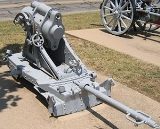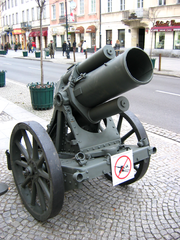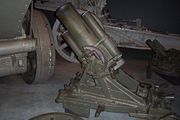
25 cm schwere Minenwerfer
Encyclopedia


Mortar (weapon)
A mortar is an indirect fire weapon that fires explosive projectiles known as bombs at low velocities, short ranges, and high-arcing ballistic trajectories. It is typically muzzle-loading and has a barrel length less than 15 times its caliber....
used by Germany in World War I. It was developed for use by engineer troops after the Siege of Port Arthur
Siege of Port Arthur
The Siege of Port Arthur , 1 August 1904 – 2 January 1905, the deep-water port and Russian naval base at the tip of the Liaotung Peninsula in Manchuria, was the longest and most violent land battle of the Russo-Japanese War....
during the Russo-Japanese War
Russo-Japanese War
The Russo-Japanese War was "the first great war of the 20th century." It grew out of rival imperial ambitions of the Russian Empire and Japanese Empire over Manchuria and Korea...
of 1905 illustrated the usefulness of this class of weapon in destroying bunkers and fortifications otherwise immune to normal artillery. It was a muzzle-loading, rifled mortar that had a standard hydro-spring recoil system. It fired two sizes of shells, 97 kg (210 lb) and 50 kg (110 lb), both of which contained far more explosive filler than ordinary artillery shells of the same caliber because the low muzzle velocity allowed for thinner shell walls and hence more space for filler. Furthermore the low velocity allowed for use of explosives like ammonium nitrate–carbon
Carbon
Carbon is the chemical element with symbol C and atomic number 6. As a member of group 14 on the periodic table, it is nonmetallic and tetravalent—making four electrons available to form covalent chemical bonds...
that were less shock-resistant than TNT, which was in short supply. This caused a large number of premature detonations that make crewing the Minenwerfer riskier than normal artillery pieces.
In 1916 a new version, with a longer barrel, was put into production. It was called the 25 cm sMW n/A (neuer Art) or new pattern while the older model was termed the a/A (alter Art) or old pattern. It is unclear what benefit this change had over the older version.
In action the sMW was emplaced in a pit, after its wheels were removed, not less than 1.5 meters deep to protect it and its crew. Despite the extremely short range, the sMW proved to be very effective as its massive shells were nearly as effective at penetrating fortifications as the largest siege guns in the German inventory, like the 42 cm Dicke Bertha or Big Bertha
Big Bertha
Big Bertha is a euphonious term for an unusually large example of a class of object; notable examples include:Military guns:* Big Bertha , a heavy mortar-like howitzer built and used by Germany during World War I...
that weighed over 50 times as much. Consequently its numbers went from 44 in service when the war broke out to some 1,234 in 1918.
Note: The data for this weapon differs between sources and cannot be considered definitive. Data provided has generally been for an a/A mortar as given at the U.S. Army Field Artillery Museum, Ft. Sill, Oklahoma
Oklahoma
Oklahoma is a state located in the South Central region of the United States of America. With an estimated 3,751,351 residents as of the 2010 census and a land area of 68,667 square miles , Oklahoma is the 28th most populous and 20th-largest state...
.

